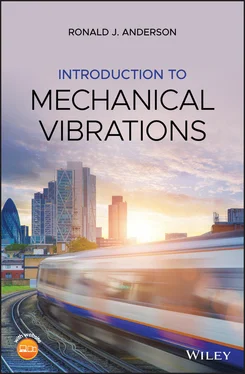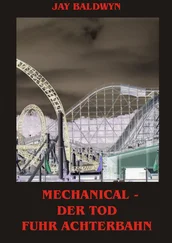10 Chapter 10Figure 10.1 An inerter implementation.Figure 10.2 A screw.Figure 10.3 The inerter symbol. Figure 10.4 Single degree of freedom system with an inerter.Figure 10.5 Free Body Diagram for the single degree of freedom system with a...Figure 10.6 Two degree of freedom system with inerters.Figure 10.7 Simplified two degree of freedom system with an inerter.Figure 10.8 A single degree of freedom system with harmonic ground motion.Figure 10.9 Free body diagram for the single degree of freedom system with h...Figure 10.10 A single degree of freedom system with an inerter and harmonic ...Figure 10.11 Free body diagram for the single degree of freedom system with ...
11 Chapter 11Figure 11.1 A measured variable  plotted versus time.Figure 11.2 The square of
plotted versus time.Figure 11.2 The square of  plotted versus time.Figure 11.3 The example function,
plotted versus time.Figure 11.3 The example function,  , plotted versus time.Figure 11.4 The DFT amplitudes of the example function,
, plotted versus time.Figure 11.4 The DFT amplitudes of the example function,  , plotted versus fr...Figure 11.5 Aliasing.Figure 11.6 The folding frequency.Figure 11.7 Aliased DFT results.Figure 11.8 The DFT for the first example.Figure 11.9 The DFT for the second example.Figure 11.10 CFT approximation to the square wave.Figure 11.11 The Hanning window.Figure 11.12 The data from Equation 11.83.Figure 11.13 The windowed data.Figure 11.14 The DFT for the second example with windowing.Figure 11.15 The DFT before downsampling.Figure 11.16 The DFT after downsampling.Figure 11.17 The time series before and after digital filtering.Figure 11.18 The DFT after decimating.Figure 11.19 A low‐pass filter circuit.Figure 11.20 Low‐pass filter frequency response in dB on a logarithmic scale...Figure 11.21 Low‐pass filter frequency response on a linear scale.Figure 11.22 Exponential moving average smoothed data.Figure 11.23 Exponential moving average DFT.Figure 11.24 Low‐pass digital filter frequency response.Figure 11.25 Low‐pass filter frequency response near the cut‐off frequency.Figure 11.26 Noisy time signal.Figure 11.27 Noisy time signal zoomed.Figure 11.28 DFT – 1 average.Figure 11.29 DFT – 10 averages.Figure 11.30 DFT – 20 averages.Figure E11.5
, plotted versus fr...Figure 11.5 Aliasing.Figure 11.6 The folding frequency.Figure 11.7 Aliased DFT results.Figure 11.8 The DFT for the first example.Figure 11.9 The DFT for the second example.Figure 11.10 CFT approximation to the square wave.Figure 11.11 The Hanning window.Figure 11.12 The data from Equation 11.83.Figure 11.13 The windowed data.Figure 11.14 The DFT for the second example with windowing.Figure 11.15 The DFT before downsampling.Figure 11.16 The DFT after downsampling.Figure 11.17 The time series before and after digital filtering.Figure 11.18 The DFT after decimating.Figure 11.19 A low‐pass filter circuit.Figure 11.20 Low‐pass filter frequency response in dB on a logarithmic scale...Figure 11.21 Low‐pass filter frequency response on a linear scale.Figure 11.22 Exponential moving average smoothed data.Figure 11.23 Exponential moving average DFT.Figure 11.24 Low‐pass digital filter frequency response.Figure 11.25 Low‐pass filter frequency response near the cut‐off frequency.Figure 11.26 Noisy time signal.Figure 11.27 Noisy time signal zoomed.Figure 11.28 DFT – 1 average.Figure 11.29 DFT – 10 averages.Figure 11.30 DFT – 20 averages.Figure E11.5
12 Chapter 12Figure 12.1 A mass on a spring.Figure 12.2 A spring connecting two masses.Figure 12.3 Lift and drag in a wind tunnel.Figure 12.4 Typical lift and drag forces versus angle of attack.Figure 12.5 A suspended airfoil in steady flow.Figure 12.6 Free body diagram of the airfoil.Figure 12.7 Representation of a von Karman vortex street in a wake.Figure 12.8 Helical strakes on tall chimneys.Figure 12.9 A railway truck supported by its two wheelsets.Figure 12.10 Parameters for a railway wheelset.Figure 12.11 Back‐to‐back cones forming a railway wheelset.Figure 12.12 Wheelset degrees of freedom.Figure 12.13 Creep forces.Figure 12.14 Wheelset free body diagram.Figure 12.15 Wheelset instability.Figure 12.16 System with a rigid body mode.Figure 12.17 The three modes.Figure 12.18 A spring/mass system.Figure 12.19 The model of a double wishbone suspension.Figure E12.1 Figure E12.3
13 Appendix AFigure A.1 Three data points and two Least Squares curve fits.
14 Appendix BFigure B.1 Parallel Axis Theorem.
1 Cover
2 Table of Contents
3 Begin Reading
1 iii
2 iv
3 v
4 xi
5 xii
6 xiii
7 xv
8 1
9 2
10 3
11 4
12 5
13 6
14 7
15 8
16 9
17 10
18 11
19 12
20 13
21 14
22 15
23 16
24 17
25 18
26 19
27 20
28 21
29 22
30 23
31 24
32 25
33 26
34 27
35 28
36 29
37 30
38 31
39 32
40 33
41 34
42 35
43 36
44 37
45 39
46 40
47 41
48 42
49 43
50 44
51 45
52 46
53 47
54 48
55 49
56 50
57 51
58 52
59 53
60 54
61 55
62 56
63 57
64 59
65 60
66 61
67 62
68 63
69 64
70 65
71 67
72 68
73 69
74 70
75 71
76 72
77 73
78 74
79 75
80 76
81 77
82 78
83 79
84 80
85 81
86 82
87 83
88 84
89 85
90 86
91 87
92 88
93 89
94 90
95 91
96 92
97 93
98 94
99 95
100 96
101 97
102 98
103 99
104 101
105 102
106 103
107 104
108 105
109 106
110 107
111 108
112 109
113 110
114 111
115 112
116 113
117 114
118 115
119 116
120 117
121 118
122 119
123 120
124 121
125 122
126 123
127 124
128 125
129 126
130 127
131 128
132 129
133 130
134 131
135 132
136 133
137 134
138 135
139 136
140 137
141 138
142 139
143 140
144 141
145 142
146 143
147 144
148 145
149 146
150 147
151 148
152 149
153 150
154 151
155 153
156 154
157 155
158 156
159 157
160 158
161 159
162 160
163 161
164 162
165 163
166 164
167 165
168 166
169 167
170 168
171 169
172 170
173 171
174 172
175 173
176 174
177 175
178 176
179 177
180 178
181 179
182 181
183 182
184 183
185 184
186 185
187 186
188 187
189 188
190 189
191 190
192 191
193 192
194 193
195 195
196 196
197 197
198 198
199 199
200 200
201 201
202 202
203 203
204 204
205 205
206 206
207 207
208 208
209 209
210 210
211 211
212 212
213 213
214 214
215 215
216 216
217 217
218 218
219 219
220 220
221 221
222 222
223 223
224 224
225 225
226 226
227 227
228 228
229 229
230 230
231 231
232 232
233 233
234 234
235 235
236 236
237 237
238 238
239 239
240 240
241 241
242 242
243 243
244 244
245 245
246 246
247 247
248 248
249 249
250 250
251 251
252 252
253 253
254 254
255 255
256 257
257 258
258 259
259 261
260 262
261 263
262 264
263 265
264 266
265 267
266 268
267 269
Introduction to Mechanical Vibrations
Ronald J. Anderson
Queen’s University
Kingston
Canada

This edition first published 2020 © 2020 John Wiley & Sons Ltd
All rights reserved. No part of this publication may be reproduced, stored in a retrieval system, or transmitted, in any form or by any means, electronic, mechanical, photocopying, recording or otherwise, except as permitted by law. Advice on how to obtain permission to reuse material from this title is available at http://www.wiley.com/go/permissions.
Читать дальше

 plotted versus time.Figure 11.2 The square of
plotted versus time.Figure 11.2 The square of  plotted versus time.Figure 11.3 The example function,
plotted versus time.Figure 11.3 The example function,  , plotted versus time.Figure 11.4 The DFT amplitudes of the example function,
, plotted versus time.Figure 11.4 The DFT amplitudes of the example function,  , plotted versus fr...Figure 11.5 Aliasing.Figure 11.6 The folding frequency.Figure 11.7 Aliased DFT results.Figure 11.8 The DFT for the first example.Figure 11.9 The DFT for the second example.Figure 11.10 CFT approximation to the square wave.Figure 11.11 The Hanning window.Figure 11.12 The data from Equation 11.83.Figure 11.13 The windowed data.Figure 11.14 The DFT for the second example with windowing.Figure 11.15 The DFT before downsampling.Figure 11.16 The DFT after downsampling.Figure 11.17 The time series before and after digital filtering.Figure 11.18 The DFT after decimating.Figure 11.19 A low‐pass filter circuit.Figure 11.20 Low‐pass filter frequency response in dB on a logarithmic scale...Figure 11.21 Low‐pass filter frequency response on a linear scale.Figure 11.22 Exponential moving average smoothed data.Figure 11.23 Exponential moving average DFT.Figure 11.24 Low‐pass digital filter frequency response.Figure 11.25 Low‐pass filter frequency response near the cut‐off frequency.Figure 11.26 Noisy time signal.Figure 11.27 Noisy time signal zoomed.Figure 11.28 DFT – 1 average.Figure 11.29 DFT – 10 averages.Figure 11.30 DFT – 20 averages.Figure E11.5
, plotted versus fr...Figure 11.5 Aliasing.Figure 11.6 The folding frequency.Figure 11.7 Aliased DFT results.Figure 11.8 The DFT for the first example.Figure 11.9 The DFT for the second example.Figure 11.10 CFT approximation to the square wave.Figure 11.11 The Hanning window.Figure 11.12 The data from Equation 11.83.Figure 11.13 The windowed data.Figure 11.14 The DFT for the second example with windowing.Figure 11.15 The DFT before downsampling.Figure 11.16 The DFT after downsampling.Figure 11.17 The time series before and after digital filtering.Figure 11.18 The DFT after decimating.Figure 11.19 A low‐pass filter circuit.Figure 11.20 Low‐pass filter frequency response in dB on a logarithmic scale...Figure 11.21 Low‐pass filter frequency response on a linear scale.Figure 11.22 Exponential moving average smoothed data.Figure 11.23 Exponential moving average DFT.Figure 11.24 Low‐pass digital filter frequency response.Figure 11.25 Low‐pass filter frequency response near the cut‐off frequency.Figure 11.26 Noisy time signal.Figure 11.27 Noisy time signal zoomed.Figure 11.28 DFT – 1 average.Figure 11.29 DFT – 10 averages.Figure 11.30 DFT – 20 averages.Figure E11.5











